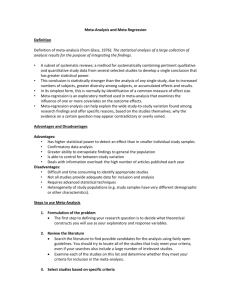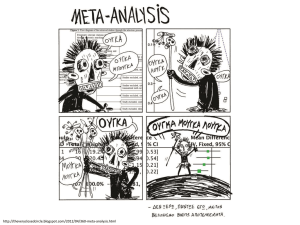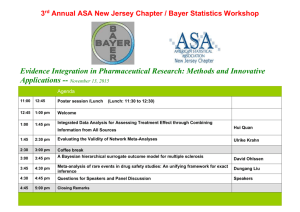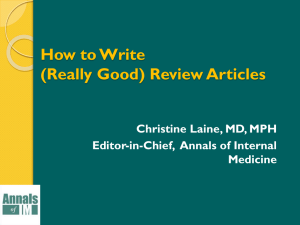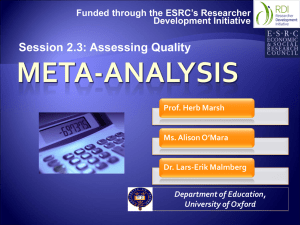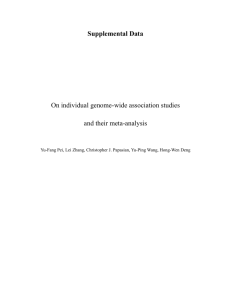meta-analysis presentation - the Centre for Cognitive Ageing and
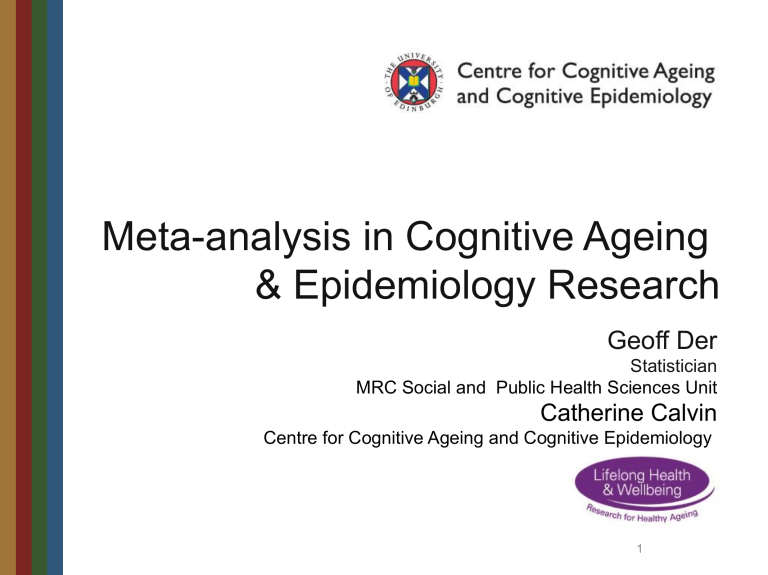
Meta-analysis in Cognitive Ageing
& Epidemiology Research
Geoff Der
Statistician
MRC Social and Public Health Sciences Unit
Catherine Calvin
Centre for Cognitive Ageing and Cognitive Epidemiology
1
In this session:
• What is meta-analysis?
• When is it appropriate to use?
• Statistical methods
• Software programmes
• Publishing meta-analyses
2
Karl Pearson (1904) conducted the first meta-analysis commissioned by the British government on the effects of a typhoid vaccination
Gene Glass (1974) coined
‘meta-analysis’: “… the analysis of analyses. It connotes a rigorous alternative to the casual, narrative discussions of research studies which typify our attempts to make sense of the rapidly expanding research literature”.
3
What is meta-analysis?
• “ Statistical combination of results from two or more separate studies ” to answer a common question
Why?
• To provide a test with more power than separate studies
• To summarise numerous and inconsistent findings
• To investigate consistency of effect across different samples http://www.cochrane-handbook.org/
4
What questions are addressed?
1. What is the direction of the effect?
2. What is the size of the effect?
3. Is the effect consistent across studies?
(heterogeneity)
4. What is the strength of evidence for the effect?
(quality assessment) http://www.cochrane-handbook.org/
5
Some Background – Clinical Trials
• Early trials show larger effects than later trials
• Better designed trials show smaller effects
• Larger trials show smaller effects
‘Natural history’ of novel interventions
Proliferation of small underpowered trials
Pocock, S J Clinical Trials A Practical Approach. Wiley 1983.
6
When is it appropriate?
• Observational and Intervention studies
• How many studies make it worth while?
• Are there additional exclusion criteria for metaanalyses?
Very small studies
Poor quality
Duplicate publications, e.g. in longitudinal studies
Results not in suitable format? (But can approach authors)
Greenland, Epidemiologic Reviews 1987;9
7
Statistical methods
• Effect measures (transformations; direction and magnitude of effect)
• Heterogeneity: random and fixed effects
• Publication bias
• Quality assessment and sensitivity analyses: bias and confounding; subgroup analysis or meta-regression?
8
Effect Size Measures
Continuous outcome
Standardised Mean difference
Cohen’s d
Hedges’ g
Glass’s Δ
Binary outcome
Odds Ratio
Relative Risk
Survival
Hazard ratio
9
Effect Size Measures
Transform reported effect sizes to common measure
Eg measures of spread/variance: CI, SD, SE, IQR
• Converting odds ratios to continuous outcome effect sizes, or vice versa
(Chinn, Statistics in Medicine , 2000;19:3127)
• HR ~ OR ~ RR when the risk of an event is low : <20%
(Symons et al, J Clin Epidemiol , 2002;55:893-99).
Take care and check results!
Online effect size calculator: http://www.campbellcollaboration.org/resources/effect_size_input.php
10
Forest Plot – odds ratios
11
Example: RR with CIs
High physical activity & Cognitive decline (Sofi et al, J Internal Med , 2010;269:107-117)
12
Example: HR with CIs
Childhood IQ and risk of mortality (Calvin et al., 2010)
13
Forest Plot – mean difference
14
Example: standardised mean difference
Wald et al, Am J Medicine , 2010;123(6):522-7
15
Random versus fixed effects
• Is each study in your review estimating the same quantity?
( fixed effects ) e.g. Mantel-Haenszel , Peto odds ratio , Inverse variance methods
• Or, are there differences in study sample and/or design that contribute to the effect size? ( random effects ) e.g.
DerSimonian and Laird method
16
Heterogeneity
Variability between studies from your systematic review, caused by differences in:
- Study samples (e.g. healthy, clinical)
- Interventions or outcomes
- Methodology: design, measures, quality etc.
“ Statistical heterogeneity manifests itself in the… [study] effects being more different from each other than one would expect due to random error (chance) alone ”
(Cochrane Handbook)
17
Assessing heterogeneity
• Visual inspection:
- confidence intervals have poor overlap
• Formal test:
- Chi-squared: are observed differences compatible with chance alone?
(NB. low power with small number of studies; p >
0.10 gives greater confidence of no heterogeneity)
But, isn’t there always clinical and methodological diversity?
• Additionally, look at the impact of heterogeneity on your aggregate estimate: inconsistency ( I 2 > 50%)
18
Dealing with heterogeneity
• Check data!
• Consider whether a meta-analysis is the right course
• Explore the causes of heterogeneity: subgroup analysis or meta-regression
• Choose random effect meta-analysis
• Change the effect measure
• Exclude outlying studies
Must be dealt with sensitively and with a good rationale for the methods used
19
Subgroup Analyses
• Dividing your studies by a design feature:
• Participant characteristic (sex, age, clinical diagnoses, geographical region)
• Study design characteristic (type of intervention, length of follow-up, type of measure used, e.g. cognitive function)
• NB. More subgroup analyses increase the risk of false negatives and false positives (patients being denied an effective treatment, or given a harmful / ineffective one)
• No formal test: what extent do the CIs overlap?
20
Meta-regression
• Only appropriate in meta-analyses of 10 or more studies
• The outcome variable is the effect estimate
• The explanatory variable(s) is the characteristic of study design that may influence the magnitude of the effect: potential effect modifier or covariate
21
Subgroup analyses & meta-regression
Considerations of both
• Are there enough studies that include the specified characteristics to justify these methods?
• Specify the characteristics in advance
• Keep numbers of characteristics to a minimum
• Is there adequate scientific rationale?
• Does one characteristic confound another?
22
Publication bias:
Addressing file drawer effects
“To control resulting overall effect sizes for publication bias, several tests were performed.
These tests consisted of visual inspection of funnel plots (Light & Pillemer, 1984),
Rosenthal's Fail-safe N (Rosenthal, 1979), a weighted Failsafe N (Rosenberg, 2005),
Orwin's Fail-safe N (Orwin, 1983), Begg and Mazumdar's rank correlation method
(Begg & Mazumdar, 1994), Egger's regression test (Egger, Smith, Schneider, &
Minder, 1997; Sterne & Egger, 2005), trim-and-fill analysis (Duval & Tweedie, 2000) following the approach as suggested by Peters, Sutton, Jones, Abrams and Rushton
(2007), a sensitivity analysis for publications bias as suggested by Vevea and
Woods (2005), and a method based on truncated normal distributions (Formann,
2008).
Application of this multitude of differential approaches originates in the increased awareness of problems of publication bias in general and the corresponding recent developments of enhanced methods to account for it.”
Pietschnig et al, Intelligence , 2010;38:314-23.
23
Funnel plots
24
Funnel plots
25
Funnel plots
26
Publication bias: cognitive epidemiology
0.08
0.1
0.12
0.14
0.16
0.18
0.2
0
0.02
0.04
0.06
0.3
0.4
0.5
0.6
0.7
HR
0.8
0.9
1 1.1
1.2
Childhood IQ and risk of mortality (Calvin et al., 2010)
27
Trim-and-fill
“The trim and fill algorithm is based on a formalization of the qualitative approach using the funnel plot. Simply put, we trim off the asymmetric outlying part of the funnel after estimating how many studies are in the asymmetric part.
We then use the symmetric remainder to estimate the true centre of the funnel and then replace the trimmed studies and their missing counterparts around the centre. The final estimate of the true mean, and also its variance, are then based on the filled funnel plot .”
Duval & Tweedie, Biometrics, 2000;56(2):455-63.
28
Quality assessment
• To control for bias, particularly in observational studies
• Descriptive, or analytical?
• Published reviews of quality checklists/tools for RCTs
(Moher et al , 1995;12:62-73) and observational studies
(Sanderson et al ,
2007;36:666-76)
• Independent (and blinded?) quality scoring
• Plot effect estimate against quality score. Is there an association?
• Quality score as covariate or weighted variable in regression
• Or, simply exclude low quality studies
29
Software: specially built programmes
Comprehensive Meta-Analysis (CMA)
MetAnalysis
MetaWin
MIX Free
RevMan Free
WEasyMA
Bax et al, BMC Med Res Meth , 2007;7:40.
30
Comprehensive Meta-Analysis
31
Software: MA routines and macros
R http://cran.r-project.org/web/packages/rmeta/rmeta.pdf
STATA http://www.medepi.net/meta/software/STATA_Metaanalysis_commands
_V6_March2004.pdf
SAS http://www.senns.demon.co.uk/SAS%20Macros/SASMacros.html
WinBUGS (Bayesian) http://www.openbugs.info/w/
32
Publishing a meta-analysis
• Consider which journals have an interest in publishing meta-analyses - what are their instructions to authors?
• Does the quantitative reporting of results from metaanalysis reduce the need for qualitative discussion more typical of a systematic review?
• Are there standard protocols for writing up? Yes,
MOOSE…
33
MOOSE Checklist
34
MOOSE Checklist cont…
Stroup et al, JAMA, 2000;283(15):2008-12.
35
Resources
Introduction to meta-analysis
Cochrane Handbook for Systematic Reviews of Interventions 4.2.6 (Sept 2006) (PDF) pages 97-166, or, the latest version available to view online: Higgins JPT, Green S
(editors). Cochrane Handbook for Systematic Reviews of Interventions Version 5.0.2
[updated September 2009]. The Cochrane Collaboration, 2009. Available from www.cochrane-handbook.org
Stangl DK, Berry DA. Meta-analysis in Medicine and Health Policy , New York, NY: Marcel
Dekker, 2000. [Large focus on Bayesian approach].
Sutton AJ, Abrams KR, Jones DR, Sheldon TA, Song F. Methods for Meta-analysis in
Medical Research . Chichester, UK: John Wiley & Sons, 2000. Including:
- Chapter 16 on Meta-analysis of Epidemiological and Observational Studies
Wolf FM. (1986). Meta-analysis: quantitative methods for research synthesis . Sage
Publications.
36
Resources
Meta-analytic methods
Bax et al (2007) A systematic comparison of software dedicated to meta-analysis of causal studies. BMC Medical Research Methodology 2007, 7:40
Chinn, C. (2000). A simple method for converting an odds ratio to effect size for use in meta-analysis. Statistics in Medicine , 19:3127{3131)
Duval S, Tweedie S. (2000). Trim and Fill: A Simple Funnel-Plot-Based Method of Testing and Adjusting for Publication Bias in Meta-Analysis. Biometrics , 56(2), 455-463.
Greenland S. Interpretation and choice of effect measures in epidemiologic analyses. Am
J Epidemiol 1987;125: 761 –8.
Sterne JA, Egger M. (2001). Funnel plots for detecting bias in meta-analysis: Guidelines on choice of axis. Journal of Clinical Epidemiology 54 (2001) 1046 –1055.
Sutton AJ, Abrams KR, Jones DR, Sheldon TA, Song F. Methods for Meta-analysis in
Medical Research . Chichester, UK: John Wiley & Sons, 2000. Including:
- Chapters 3 to 9
37
Resources
Reporting a meta-analysis
Stroup DF, Berlin JA, Morton SC; et al. Meta-analysis of Observational Studies in
Epidemiology: A Proposal for Reporting. JAMA . 2000;283(15):2008-2012
MOOSE (Meta-Analysis of Observational Studies in Epidemiology). This checklist for reporting observational studies was developed following a workshop convened to address the problem of increasing diversity and variability that exist in reporting metaanalyses of observational studies. (Stroup et al., 2000). Checklist: http://jama.ama-assn.org/cgi/content/full/283/15/2008/TABLEJST00003T1
Cochrane Handbook for Systematic Reviews of Interventions 4.2.6 (Sept 2006) (PDF) pages 147-150: 8.9 Presenting, illustrating and tabulating results . Available from www.cochrane-handbook.org
Sutton AJ, Abrams KR, Jones DR, Sheldon TA, Song F. Methods for Meta-analysis in
Medical Research . Chichester, UK: John Wiley & Sons, 2000. Including:
- Chapter 10 Reporting the Results of Meta-analysis
38
Thank you
Contact: G.Der@sphsu.mrc.ac.uk
39
